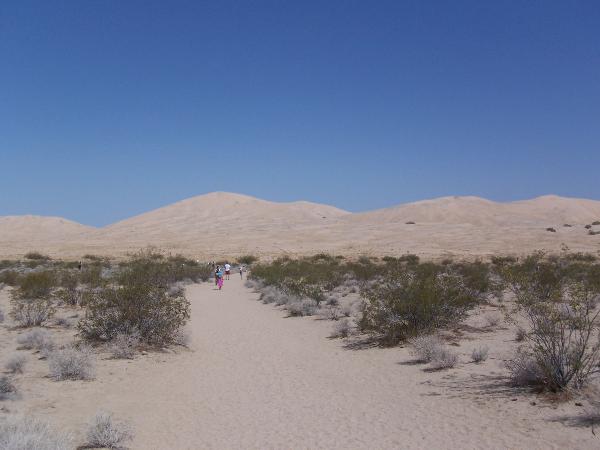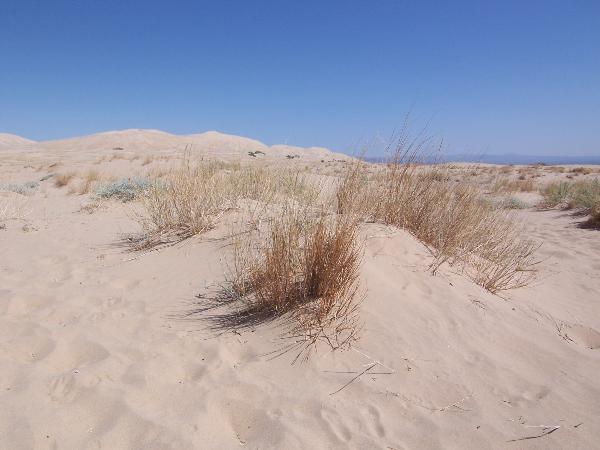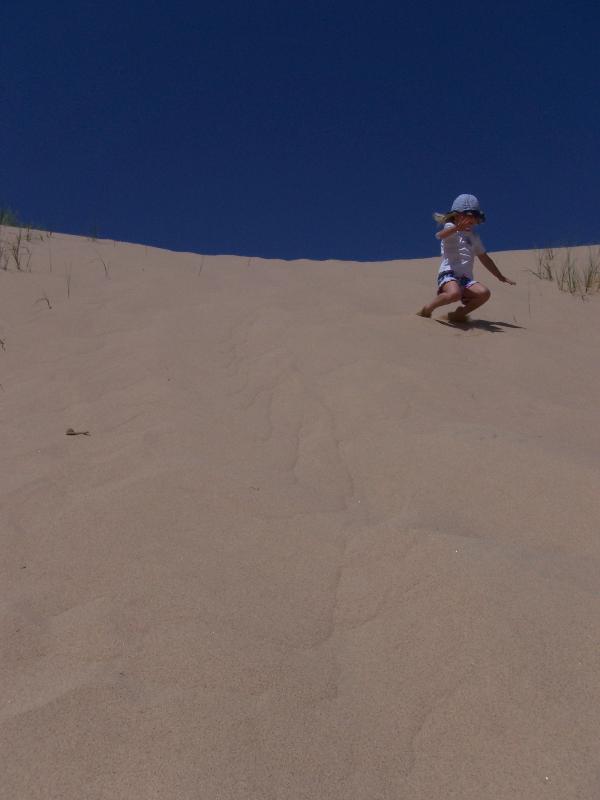
 A graded dirt road leads to the parking area just south of the dunes. There is a set of pit toilets, but no water. Be aware of the potential for high temperatures and prepare accordingly. The dunes are an official wilderness area.
A graded dirt road leads to the parking area just south of the dunes. There is a set of pit toilets, but no water. Be aware of the potential for high temperatures and prepare accordingly. The dunes are an official wilderness area.
Eolean Transport
The sand of these dunes has been transported to this location by the regional winds. Like water, wind transports grains by one of three methods, suspension (picked up by the wind and carried along with it), saltation (grains that are picked up, moved a short distance then fall back down, bouncing), or impact creep (grains that are nudged along by saltating grains)  depending upon the speed of the wind and the size of the grain. Only the smallest and thus lightest grains can be suspended by air, while the heavier grains either saltate or are moved by impact creep.
depending upon the speed of the wind and the size of the grain. Only the smallest and thus lightest grains can be suspended by air, while the heavier grains either saltate or are moved by impact creep.
The moving sand quickly begins forming ridges. These ripples are a few inches from top to top and less than an inch high. They are tiny versions of the large dune and are formed in the same way. Sand is moved up to the top of the ridge and then the ridge collapses when it gets too steep. The angle that the sand begins to slide is called the angle of repose. Over time this process slowly migrates the dune in the direction of the wind.
 Wind can only move loose grains. Once plants get established in the sand, the plants stabilize the dune. The Kelso Dunes include not only the tall active dunes that are so easy to see but also the relict sand dunes and sand sheets surrounding the active dunes that have been stabilized by the desert plants. As you walk toward the active dune you can see that the areas where plants have begun to grow tend to be higher than the surrounding sand.
Wind can only move loose grains. Once plants get established in the sand, the plants stabilize the dune. The Kelso Dunes include not only the tall active dunes that are so easy to see but also the relict sand dunes and sand sheets surrounding the active dunes that have been stabilized by the desert plants. As you walk toward the active dune you can see that the areas where plants have begun to grow tend to be higher than the surrounding sand.
These dunes show on a small scale the eolean (wind derived) processes that have created the large crossbedded sandstone formations such as the Aztec Sandstone of the Mojave and Navajo Sandstone in Zion Canyon.
The Source of the Sand
All this sand had to come from somewhere. Much of the sand apparently was transported down the Mojave River from the San Bernadino Mountains to Soda Lake (located to the northwest) when the area received more rainfall. As the rainfall decreased over time, the lake dried up exposing the sand that filled the basin. Regional wind patterns from the northwest began blowing the sand southeast. As the wind encountered the Granite Mountains just south of the coordinates, the wind was directed upward and slowed dropping the sand. This pattern repeated at least 5 times over the past 25,000 years creating the larger dune complex that extends off to the northwest toward Soda Lake called the Devil's Playground and ends here at Kelso Dunes.
Additionally, some of the sand was also washed down from the surrounding mountains creating a slightly different composition of sand at the southern end of the dune complex.
Sand Composition
From a distance only the tall active dunes are easily identifiable and appear made of one type of sand. Closer inspection reveals a variety of minerals can be found in the dunes. The light colored quartz and feldspar predominate. However, the wind patterns somehow concentrate darker minerals near the surface of the dune crests. These darker minerals are magnetite and amphibole. You can use a magnet to easily pick up the small bits of magnetite.
 Booming or Singing Sands
Booming or Singing Sands
One of the most famous features of these dunes is its booming or singing. Sand sliding down from the dune crests creates an audible sound that has been likened to a low-flying propeller plane. Research has shown that only medium grained, well-rounded, extremely smooth, frosted sand grains will produce sounds. In addition, the sand must be extremely dry, less than 1% moisture.
If the sands are not naturally sliding, go ahead and shove some over a crest and listen.
Logging requirements:
Send me a note with :
- The text "GC13ENE Kelso Dunes" on the first line
- The number of people in your group.
- your observations of how sand was being transported compared to the wind speed during your visit;
- your observations of the effect of plant colonization on the dune or on a windy day flatten a section of sand that has ripples on it and see how long it takes for the ripples to reform;
- compare the amount of magnetite in a light colored area of the dune to a dark colored dune crest.
- AND Include in your log your experiments of getting the dunes to sing for you. Include reasons why you were successful or unsuccessful.
The above information was compiled from the following sources:
- • DENNIS T. TREXLER and WILTON N. MELHORN, Singing and Booming Sand Dunes of California and Nevada, , California Geology 39(7), pp. 147-152, July 1986, http://www.schweich.com/sbdA.html
- John Mangimeli, Geology of Sand Dunes , , http://www.nps.gov/archive/whsa/Sand%20Dune%20Geology.htm
- Geology of Mojave National Preserve: Kelso Dunes, http://geomaps.wr.usgs.gov/parks/mojave/kelso1.html
- Sharp and Glazner, 1993 Geology Underfoot in Southern California, Mountain Press Publishing Company.
Placement approved by the
Mojave National Preserve